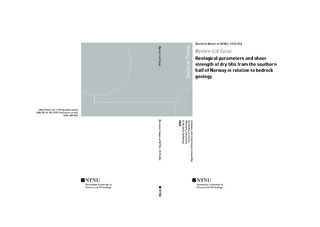| dc.description.abstract | When excluding floods, it is primarily slope stability issues such as landslides and avalanches, which count for the main geohazards in Norway. Till is the dominant Quaternary sediment, where the till deposits mostly originate from local rocks with a transport distance less than five kilometres. Consequently, debris slides and debris flows are among the main geohazards on till-covered valley slopes. In this context, the shear strength of tills is poorly studied. In addition, available documentation and data supporting so-called ‘known relationships’ of bedrock geology to geological parameters of till, such as particle size distribution, particle shape, and the mineralogical composition seem to be rather poor or based on outdated or nonstandardised test methods. These geological parameters are also known to influence soil shear strength. To improve the knowledge on this subject, a set of 33 nearsurface, genetically independent till samples were collected from various locations in the southern half of Norway to investigate the relationships between shear strength, geological parameters, and bedrock geology. The samples were categorized into six regional rock provinces, i.e., the Precambrian basement, the Oslo region, and four provinces in the Caledonian orogen, with five to seven samples in each. The mapped rock type(s) assumed to represent the origin of the till samples were based on their area of extent around the sample sites, and adjusted for by the late Weichselian ice-flow directions. Furthermore, the disturbed samples were sieved (<16 mm) and dried before they were tested in a large-scale direct shear box apparatus. Drying was done to exclude water as a variable, so that the results could be linked to the geological parameters of the material. In addition, a portion of riffled material from each sample was prepared and tested to determine the different geological parameters from six tests, i.e., particle size distribution, flakiness index, shape index, roundness, surface texture, and XRD analysis. The mutual correlations between the geological parameters and their correlations to dry till shear strength were investigated to display the potential relationships amongst the till samples and rock provinces.
Categorised by the rock provinces, named A/B–G, the results are generally in accordance with expectations regarding the relation of such geological parameters to the differences of bedrock geology amongst the provinces. For example, the Caledonian province of metamorphic and igneous rocks (E) had on average a higher fines content and a higher share of flaky/elongated particles than the Caledonian province of Precambrian rocks locally affected by the Caledonian orogeny (G). Rock provinces E and G are represented by rocks such as mica schist and phyllite, and various gneisses, respectively. In addition, the XRD analysis showed that province G was dominated by feldspars, while the Caledonian province of overthrust sheets of sandstone and schist (F), which is mainly represented by sandstones, was dominated by quartz. The results also indicate that the dry till shear strength is not specifically governed by one geological parameter, but rather by an interaction of all the parameters combined. Particle size distribution and mineralogical composition were found to relate to the angle of friction, while particle shape is considered to influence the initial shear resistance and may thus be of special importance regarding the potential initiation of debris slides and flows in the respective provinces. On a province level, the study provides indications of a relation between dry till shear strength and bedrock geology with associated geological parameters. This suggests that some rock provinces may, solely on the basis of their associated geological parameters, be more prone to debris slides and flows than others. For this case, province G was found to be the ‘strongest’ province, while province F was found to be the ‘weakest’ province. The overall project objective is that the results of the study may improve the forecasts of the existing online Norwegian debris-slide warning system (‘Jordskredvarsling’), which at the present does not directly include the investigated parameters.
However, it must be emphasised that the number of samples tested is relatively few, and they are geographically scattered. The samples were also collected without considerations of their genesis, which is known to influence several till characteristics. Moreover, the testing procedures and thus the results do not replicate individual field/in-situ conditions at the sample sites, as the samples were disturbed when collected and prepared for the purpose of achieving an equal comparison basis with a minimum of laboratory variables. In addition, it is important to emphasise that what makes an area prone to debris slides and flows depends on many other parameters, e.g., terrain characteristics, hydrological conditions, vegetation, etc. | nb_NO |
